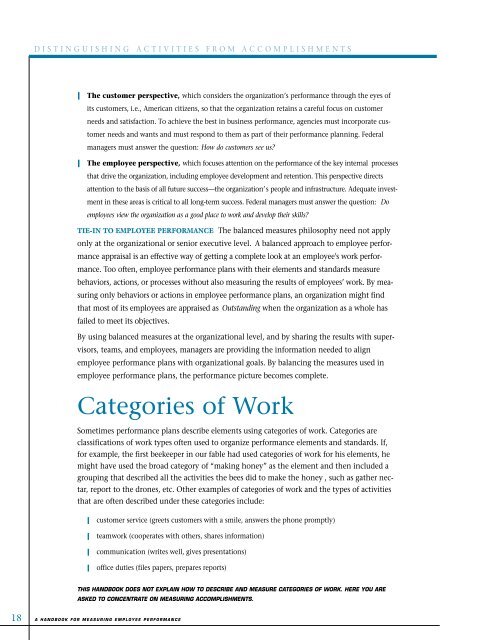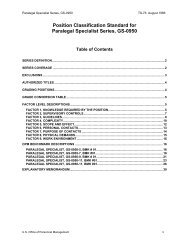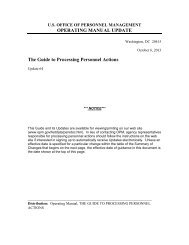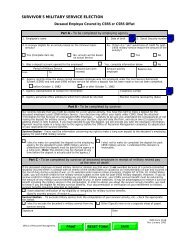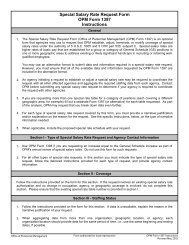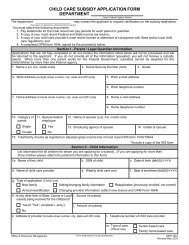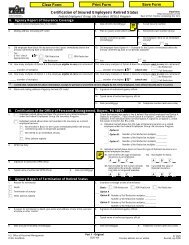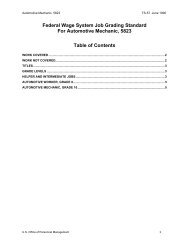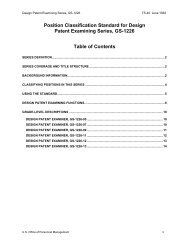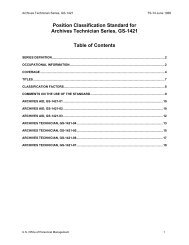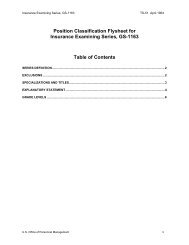A Handbook for Measuring Employee Performance - Office of ...
A Handbook for Measuring Employee Performance - Office of ...
A Handbook for Measuring Employee Performance - Office of ...
You also want an ePaper? Increase the reach of your titles
YUMPU automatically turns print PDFs into web optimized ePapers that Google loves.
18<br />
DISTINGUISHING ACTIVITIES FROM ACCOMPLISHMENTS<br />
❙ The customer perspective, which considers the organization’s per<strong>for</strong>mance through the eyes <strong>of</strong><br />
its customers, i.e., American citizens, so that the organization retains a careful focus on customer<br />
needs and satisfaction. To achieve the best in business per<strong>for</strong>mance, agencies must incorporate customer<br />
needs and wants and must respond to them as part <strong>of</strong> their per<strong>for</strong>mance planning. Federal<br />
managers must answer the question: How do customers see us?<br />
❙ The employee perspective, which focuses attention on the per<strong>for</strong>mance <strong>of</strong> the key internal processes<br />
that drive the organization, including employee development and retention. This perspective directs<br />
attention to the basis <strong>of</strong> all future success—the organization’ s people and infrastructure. Adequate investment<br />
in these areas is critical to all long-term success. Federal managers must answer the question: Do<br />
employees view the organization as a good place to work and develop their skills?<br />
TIE-IN TO EMPLOYEE PERFORMANCE The balanced measures philosophy need not apply<br />
only at the organizational or senior executive level. A balanced approach to employee per<strong>for</strong>mance<br />
appraisal is an effective way <strong>of</strong> getting a complete look at an employee's work per<strong>for</strong>mance.<br />
Too <strong>of</strong>ten, employee per<strong>for</strong>mance plans with their elements and standards measure<br />
behaviors, actions, or processes without also measuring the results <strong>of</strong> employees’ work. By measuring<br />
only behaviors or actions in employee per<strong>for</strong>mance plans, an organization might find<br />
that most <strong>of</strong> its employees are appraised as Outstanding when the organization as a whole has<br />
failed to meet its objectives.<br />
By using balanced measures at the organizational level, and by sharing the results with supervisors,<br />
teams, and employees, managers are providing the in<strong>for</strong>mation needed to align<br />
employee per<strong>for</strong>mance plans with organizational goals. By balancing the measures used in<br />
employee per<strong>for</strong>mance plans, the per<strong>for</strong>mance picture becomes complete.<br />
Categories <strong>of</strong> Work<br />
Sometimes per<strong>for</strong>mance plans describe elements using categories <strong>of</strong> work. Categories are<br />
classifications <strong>of</strong> work types <strong>of</strong>ten used to organize per<strong>for</strong>mance elements and standards. If,<br />
<strong>for</strong> example, the first beekeeper in our fable had used categories <strong>of</strong> work <strong>for</strong> his elements, he<br />
might have used the broad category <strong>of</strong> “making honey” as the element and then included a<br />
grouping that described all the activities the bees did to make the honey , such as gather nectar,<br />
report to the drones, etc. Other examples <strong>of</strong> categories <strong>of</strong> work and the types <strong>of</strong> activities<br />
that are <strong>of</strong>ten described under these categories include:<br />
❙ customer service (greets customers with a smile, answers the phone promptly)<br />
❙ teamwork (cooperates with others, shares in<strong>for</strong>mation)<br />
❙ communication (writes well, gives presentations)<br />
❙ <strong>of</strong>fice duties (files papers, prepares reports)<br />
THIS HANDBOOK DOES NOT EXPLAIN HOW TO DESCRIBE AND MEASURE CATEGORIES OF WORK. HERE YOU ARE<br />
ASKED TO CONCENTRATE ON MEASURING ACCOMPLISHMENTS.<br />
A HANDBOOK FOR MEASURING EMPLOYEE PERFORMANCE


